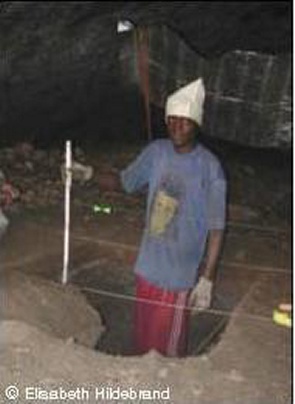









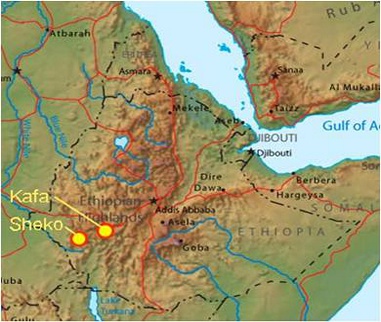
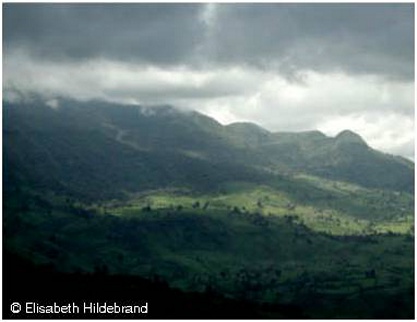
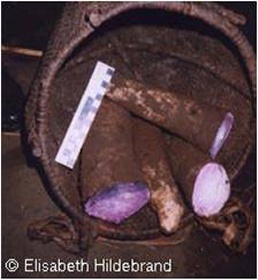
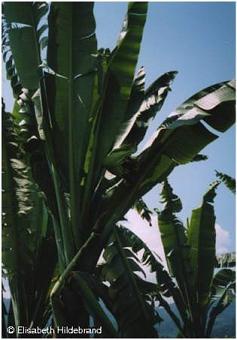
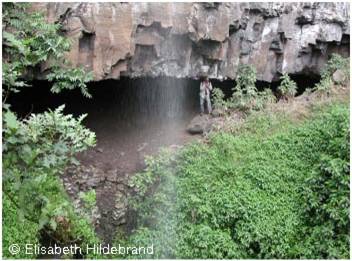
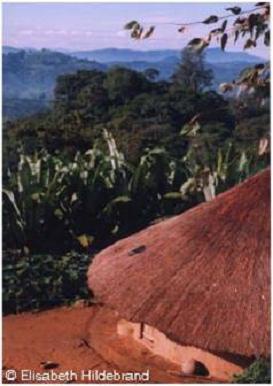
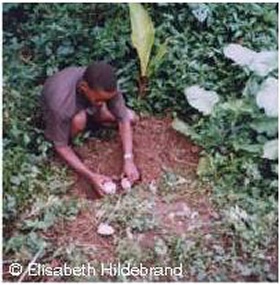
History of research
Ethiopia is one of the world’s major centers for indigenous plant domestication. Local crops include grains (t’ef), oilseeds (noog), and crops grown for their underground storage organs (yam, enset). Because little field research was done on the origins of these crops prior to the 1990s, archaeologists had little definitive to say on when, how, and why indigenous Ethiopian crops first came under human cultivation.
Ethiopia is one of the world’s major centers for indigenous plant domestication. Local crops include grains (t’ef), oilseeds (noog), and crops grown for their underground storage organs (yam, enset). Because little field research was done on the origins of these crops prior to the 1990s, archaeologists had little definitive to say on when, how, and why indigenous Ethiopian crops first came under human cultivation.
Initial efforts were led by Catherine D’Andrea (origins of t’ef), Steven Brandt
(modern enset production across southern and southwest Ethiopia), and
myself (ethnobotanical and ethnoarchaeological study of use of enset,
yams, and wild resources by the Sheko of SW Ethiopia).
Later, I collaborated with Brandt on the first archaeological survey and excavations in Kafa, southwest Ethiopia, seeking evidence for early farming.
Later, I collaborated with Brandt on the first archaeological survey and excavations in Kafa, southwest Ethiopia, seeking evidence for early farming.
Environmental context
Due to repeated droughts and famines in the Horn of Africa, foreigners often assume the entire region is hot and dry. However, southwest Ethiopia has highlands that capture large amounts of rainfall (>2000 mm/year) and have cool temperatures. These conditions sustain a natural vegetation of Afromontane forests, which at descending elevations give way to broadleaf forests and wooded grasslands. Steep slopes produce marked changes in rainfall, temperature, and vegetation, so many different ecological zones are present within a small area. These conditions make southwest Ethiopia and surrounding areas an unusual context for plant domestication.
Due to repeated droughts and famines in the Horn of Africa, foreigners often assume the entire region is hot and dry. However, southwest Ethiopia has highlands that capture large amounts of rainfall (>2000 mm/year) and have cool temperatures. These conditions sustain a natural vegetation of Afromontane forests, which at descending elevations give way to broadleaf forests and wooded grasslands. Steep slopes produce marked changes in rainfall, temperature, and vegetation, so many different ecological zones are present within a small area. These conditions make southwest Ethiopia and surrounding areas an unusual context for plant domestication.
Enset (Ensete ventricosum, Musaceae),
growing in Sheko homegarden.
Yam tubers (Dioscorea sp.) harvested by
Sheko farmers.
Crops indigenous to southwest Ethiopia are unlike the
grains and legumes whose domestication has captured
scientific interest in other parts of the globe.
Enset, a member of the banana family, has a large edible, starchy underground corm that can feed a family for days. An enset plant takes several years to grow, during which its leaves provide bedding, wrappers, and construction material. Once mature, an enset corm can be harvested any time of the year.
Yams provide a complementary source of starch that is better tasting but only available in certain seasons. Wild yams grow well in warm lowland areas with plenty of sun. In uplands where they must compete with heavy vegetation, they thrive in disturbed areas.
Enset, a member of the banana family, has a large edible, starchy underground corm that can feed a family for days. An enset plant takes several years to grow, during which its leaves provide bedding, wrappers, and construction material. Once mature, an enset corm can be harvested any time of the year.
Yams provide a complementary source of starch that is better tasting but only available in certain seasons. Wild yams grow well in warm lowland areas with plenty of sun. In uplands where they must compete with heavy vegetation, they thrive in disturbed areas.
Crops
Ethnobotanical & ethnoarchaeological research
Grants from the National Science Foundation and the Wenner-Gren Foundation allowed me to live in a remote area among southwest Ethiopia's Sheko people for 18 months. The Sheko grow enset and yams, and live adjacent to forests in upland and mid-altitude settings. Residing in a Sheko village, and conducting cultural ecology surveys throughout Sheko territory, revealed how horticultural systems operate in conditions of low population density in southwest Ethiopia. I also learned what wild resources are available at different altitudes and times of year, and how wild plants and animals and honey can contribute to subsistence.
Surveys of resources' seasonal and spatial distributions allowed me to reconstruct possible subsistence calendars for prehistoric hunter-gatherers. Understanding how people schedule their use of the wild plants, animals, and honey available in different settings can help us model how prehistoric people might have come to intensify use of certain resources.
Grants from the National Science Foundation and the Wenner-Gren Foundation allowed me to live in a remote area among southwest Ethiopia's Sheko people for 18 months. The Sheko grow enset and yams, and live adjacent to forests in upland and mid-altitude settings. Residing in a Sheko village, and conducting cultural ecology surveys throughout Sheko territory, revealed how horticultural systems operate in conditions of low population density in southwest Ethiopia. I also learned what wild resources are available at different altitudes and times of year, and how wild plants and animals and honey can contribute to subsistence.
Surveys of resources' seasonal and spatial distributions allowed me to reconstruct possible subsistence calendars for prehistoric hunter-gatherers. Understanding how people schedule their use of the wild plants, animals, and honey available in different settings can help us model how prehistoric people might have come to intensify use of certain resources.
Sheko house and homegarden.
Morphological comparisons of wild vs. domestic enset have revealed how specific
needs may have shaped selection processes during prehistoric domestication events. In
contrast to conventional wisdom that domestication was done to increase yield, my
studies showed that enset domestication resulted in a smaller but more palatable
underground starch organ.
Archaeological research
Although every known instance of plant domestication throughout the world has taken place during the past 11,000 years (the Holocene period), no Holocene archaeological research had been done in southwest Ethiopia. In 2004-2006, a Fulbright fellowship and a Wenner-Gren grant allowed me and colleague Steven Brandt to do survey and test excavations in Kafa. Of 29 rockshelters found, five yielded artifacts demonstrating prehistoric occupation. Because they span an altitudinal gradient from 1300-2200 m, their contents should allow comparisons of highland & lowland material culture and plant use, including use of domesticates. Kumali Rockshelter has dried plant remains whose quantity and preservation is unequalled anywhere in northeast Africa. Its 5000-year sequence provides the first outline of cultural chronology for this part of Ethiopia.
Although every known instance of plant domestication throughout the world has taken place during the past 11,000 years (the Holocene period), no Holocene archaeological research had been done in southwest Ethiopia. In 2004-2006, a Fulbright fellowship and a Wenner-Gren grant allowed me and colleague Steven Brandt to do survey and test excavations in Kafa. Of 29 rockshelters found, five yielded artifacts demonstrating prehistoric occupation. Because they span an altitudinal gradient from 1300-2200 m, their contents should allow comparisons of highland & lowland material culture and plant use, including use of domesticates. Kumali Rockshelter has dried plant remains whose quantity and preservation is unequalled anywhere in northeast Africa. Its 5000-year sequence provides the first outline of cultural chronology for this part of Ethiopia.
Kafa Archaeological Project team member
Kochito Kero at excavations of Kumali
Rockshelter.
Future plans
Our team plans to extend excavations at several of the Kafa rockshelters, survey open-air contexts in the same area, and conduct survey and excavation in other parts of the southwest Ethiopian highlands and lowlands. Analysis and publication of botanical, faunal, and artifactual finds is continuing.
Our team plans to extend excavations at several of the Kafa rockshelters, survey open-air contexts in the same area, and conduct survey and excavation in other parts of the southwest Ethiopian highlands and lowlands. Analysis and publication of botanical, faunal, and artifactual finds is continuing.
Publications on southwest Ethiopian research: Ethnobotany & ethnoarchaeology
Early considerations of these issues were offered by Steven Brandt in 1984 and 1996
Hildebrand, Elisabeth. 2003a. Comparison of domestic vs. forest-growing Ensete ventricosum (Welw.) Cheesman, Musaceae in Ethiopia: Implications for detecting enset archaeologically, and modeling its domestication. Africa Praehistorica 15. Food, Fuel, and Fields: Progress in African Archaeobotany, edited by Katharina Neumann, Ann Butler, and Stefanie Kahlheber, pp. 49-70. Heinrich Barth Institut, Köln.
Hildebrand, Elisabeth. 2003b. Motives and opportunities for domestication: an ethnoarchaeological study in southwest Ethiopia. Journal of Anthropological Archaeology 22(4):358-375.
Hildebrand, Elisabeth. 2007. A tale of two tuber crops: How attributes of enset and yams may have shaped prehistoric human-plant interactions in southwest Ethiopia. One World Archaeology series volume Rethinking Agriculture, edited by Tim Denham, Luc Vrydaghs, and Jose Iriarte. Left Coast Press, Berkeley, pp. 273-298.
Hildebrand, Elisabeth. 2009. The utility of ethnobiology in agricultural origins research: Examples from southwest Ethiopia. Current Anthropology 50:693-697.
Publications on southwest Ethiopian research: Archaeology
Elisabeth Hildebrand, Steven Brandt, and Josephine Lesur. 2010. The Holocene archaeology of southwest Ethiopia: New insights from the Kafa Archaeological Project. African Archaeological Review 27:255-289.
Elisabeth Hildebrand and Steven Brandt. 2010. An archaeological survey of the tropical highlands of Kafa, southwest Ethiopia. Journal of African Archaeology 8(1):43-63.
Early considerations of these issues were offered by Steven Brandt in 1984 and 1996
Hildebrand, Elisabeth. 2003a. Comparison of domestic vs. forest-growing Ensete ventricosum (Welw.) Cheesman, Musaceae in Ethiopia: Implications for detecting enset archaeologically, and modeling its domestication. Africa Praehistorica 15. Food, Fuel, and Fields: Progress in African Archaeobotany, edited by Katharina Neumann, Ann Butler, and Stefanie Kahlheber, pp. 49-70. Heinrich Barth Institut, Köln.
Hildebrand, Elisabeth. 2003b. Motives and opportunities for domestication: an ethnoarchaeological study in southwest Ethiopia. Journal of Anthropological Archaeology 22(4):358-375.
Hildebrand, Elisabeth. 2007. A tale of two tuber crops: How attributes of enset and yams may have shaped prehistoric human-plant interactions in southwest Ethiopia. One World Archaeology series volume Rethinking Agriculture, edited by Tim Denham, Luc Vrydaghs, and Jose Iriarte. Left Coast Press, Berkeley, pp. 273-298.
Hildebrand, Elisabeth. 2009. The utility of ethnobiology in agricultural origins research: Examples from southwest Ethiopia. Current Anthropology 50:693-697.
Publications on southwest Ethiopian research: Archaeology
Elisabeth Hildebrand, Steven Brandt, and Josephine Lesur. 2010. The Holocene archaeology of southwest Ethiopia: New insights from the Kafa Archaeological Project. African Archaeological Review 27:255-289.
Elisabeth Hildebrand and Steven Brandt. 2010. An archaeological survey of the tropical highlands of Kafa, southwest Ethiopia. Journal of African Archaeology 8(1):43-63.
Plant domestication in the southwest Ethiopian highlands
Studies of ongoing domestication by the Sheko
showed that both ecological and social factors may
influence individuals to manipulate plants. People
domesticate yams in ecological contexts where yams
are not naturally abundant, and yam domestication is
often done by single men who lack access to female labor for obtaining other plant foods.
showed that both ecological and social factors may
influence individuals to manipulate plants. People
domesticate yams in ecological contexts where yams
are not naturally abundant, and yam domestication is
often done by single men who lack access to female labor for obtaining other plant foods.
Left: Sheko farmer transplanting yams.
Left: Boreti Cave, Kafa.
Margin of highland area near Hala, Kafa, southwest Ethiopia.







